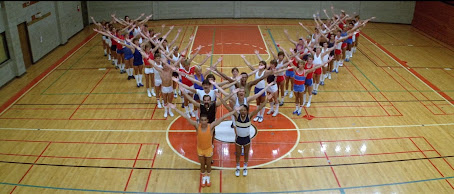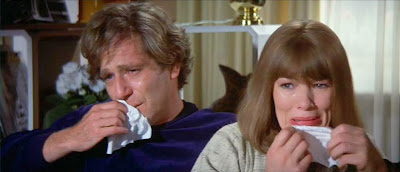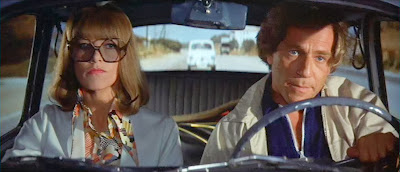For this essay ushering out the month of October and welcoming in November, I present for your edification, a movie that qualifies as both a Halloween horror and an overstuffed Thanksgiving turkey. Said turkey being Allan Carr’s notorious Can’t
Stop the Music, a longtime guilty-pleasure
favorite that, unlike most camp films in my “favorites” canon, grows
increasingly less fun to watch as time goes by.
A highly fictionalized account
(and I stress fictionalized) of the creation of the gay-themed disco singing
group Village People, Can’t Stop the Music, released in the summer of
1980, hit theaters at the worst possible time and under the worst possible
circumstances. If Xanadu—that other 1980 summer musical release that tanked at
the boxoffice—suffered from too much '80s faddism by way of roller skates, spandex, and leg
warmers, Can’t Stop the Music looked and sounded exactly like a disco
relic that had been gathering dust on the shelf since 1978.
 |
| A 1979 Trade ad from Boxoffice Magazine with the film's original title. Note the dodged-a-bullet cast members, Chita Rivera and Pat Ast. Presumably in the Altovise Davis and Marilyn Sokol roles |
 |
| Valerie Perrine as Samantha Simpson |
 |
| Steve Guttenberg as Jack Morell |
 |
| Village People as the closeted version of the Village People |
 |
| Caitlyn Jenner as Ron White |
 |
| Tammy Grimes as Sydne Channing (are they kidding with that name?) |
It also hit theaters in the wake of the earlier release of two controversial 1980 films with gay themes: Gordon Willis' Windows, about a homicidal lesbian; and William Friedkin's Cruising, a movie about a gay serial killer. Given the paucity of positive portrayals of gays in films, activist groups were wise to protest two films released within months of each other depicting homosexuals as homicidal maniacs. The heterosexual filmmakers behind these epics took a wide-eyed "Who me?" position, playing ignorant to observations that such a concentrated association of Gay=Death could only feed into the rising tide of homophobia and anti-gay violence across the country.
Into this atmosphere of what appeared to be media-sanctioned homophobia came Can't Stop the Music, a gay film that came across as being duplicitously coy about that very fact.
Had Can’t Stop the Music been made with even a shred of the strength of its flimsy convictions, I’m sure its leering “cocaine and Crisco” homogenized ode to homosexual hedonism would have come under attack as well. But at least then the film's "out and proud" dialogue: "I don't judge people. I accept them" - and anthems like Liberation would have made a little sense.
But as it stood, Can't Stop the Music failed to take any kind of stand whatsoever, for producer Allan Carr knew that much more money could be made from within the closet than outside of it.
 |
| Good, Clean, Wholesome, Hetero Fun! |
At a time when it really would have made a powerful statement to have an unashamedly out, “We’re here, we’re queer” mainstream movie in the theaters (along the lines of The Ritz or The Rocky Horror Picture Show), Allan Carr, one of the most high-profile and powerful gay men in Hollywood (especially after Grease), instead gave the world a movie so self-negating, so deeply in the closet and in denial about itself, Liberace could have been its technical advisor.
 |
| We know, James...we know |
Although
it didn't hit me as strongly in 1980 as it does now, Can’t Stop the Music,
to an almost contemptible degree, suffers from
a distasteful undercurrent of homophobic self-loathing and ideological
selling-out. In an effort to keep its many corporate sponsors happy (Dr. Pepper, Baskin-Robbins,
Famous Amos Cookies, American Dairy Association) and to court the mainstream boxoffice that made Grease into such a mega-hit, Can’t
Stop the Music systematically and schizophrenically undercuts every bit of
the film’s laid-on-with-a-trowel gay subtext with an unpersuasive overlay of bland
heterosexuality. Honestly, in spite of Can’t Stop the Music being about a gay-themed
singing group formed in New York’s Greenwich Village featuring numerous coy
allusions (acres of male flesh on display, a multitude of homoerotic double
and triple entendres) - I don’t think the word “gay” is uttered even once in the
whole film.
 |
| Olympic Gold Medalist Caitlyn Jenner, making her film debut, here achieves the impossible by actually managing to look sillier than the Village People |
To paraphrase one of my favorite Judge Judy-isms, Can’t Stop the Music is a movie that doesn't know whether it’s afoot or horseback. It courts gay dollars with its setting, its music, its "Auntie Mame syndrome" supporting cast of flamboyant elderly actresses, and its virtual non-stop parade of beefcake. Yet it doesn't want the polarizing effect (at the box-office) of actually being what it is...a big-budget, big ol' gay musical. Instead, it operates in a sex-neutral (Guttenberg’s character swears off sex until he becomes a success…how convenient), heterosexual-insistent (just WHO are those nondescript, lost-looking women clinging to the Village People during the “Magic Night” number?) limbo that makes no sense. As I mentioned earlier, at one point in the film, the Village People sing a song titled “Liberation,” but in the "Ain't nobody here but us straights!" context of the movie, what the hell kind of liberation are these guys even singing about?
In trying to be the all-things-to-all-people crowd-pleaser its sizable budget demanded, Can’t Stop the Music wound up not being much of anything to anybody.
A must-read for behind-the-scenes details on the making of this rainbow-colored fiasco is Robert Hofler's 2010 Allan Carr biography Party Animals. Wherein we learn that Carr's desire to bring back the glamour of old Hollywood extended to reviving the casting couch. In an attempt to put a male spin on the old MGM "Goldwyn Girls" tradition of featuring beautiful girls as extras and bit players throughout the film, Allan Carr made ample use of a coterie of male dancers, models, hustlers, starlets, and party boys ("Cash or career?" was purportedly Carr's standard come on when meeting a handsome young man). We also learn that director Nancy Walker and Valerie Perrine hated one another, that sizable chunks of the film were actually directed by choreographer Arlene Phillips and cinematographer Bill Butler (Grease, Jaws), and that Allan Carr harbored a near-Hitchcockian obsession with his heterosexual protegee, Steve Guttenberg.
 |
| Male starlet Victor Davis strikes a pose to show Guttenberg & Jenner just how "not gay" Can't Stop the Music is. |
 |
| Seventies bisexual porn "star" George Payne jogs by (twice!) in the excruciating Guttenberg-on-roller-skates opening sequence |
A must-read for behind-the-scenes details on the making of this rainbow-colored fiasco is Robert Hofler's 2010 Allan Carr biography Party Animals. Wherein we learn that Carr's desire to bring back the glamour of old Hollywood extended to reviving the casting couch. In an attempt to put a male spin on the old MGM "Goldwyn Girls" tradition of featuring beautiful girls as extras and bit players throughout the film, Allan Carr made ample use of a coterie of male dancers, models, hustlers, starlets, and party boys ("Cash or career?" was purportedly Carr's standard come on when meeting a handsome young man). We also learn that director Nancy Walker and Valerie Perrine hated one another, that sizable chunks of the film were actually directed by choreographer Arlene Phillips and cinematographer Bill Butler (Grease, Jaws), and that Allan Carr harbored a near-Hitchcockian obsession with his heterosexual protegee, Steve Guttenberg.
That summer, my excitement regarding the forthcoming release of Xanadu so eclipsed all else, I tend to forget that 1980 was something of a banner year for musicals. There was Alan Parker’s Fame and Saturday Night Live alums Belushi & Aykroyd brought their characters The Blues Brothers to the screen. The heavily-hyped Can’t Stop the Music wasn’t very high on my list of must-see summer films mostly due to my general antipathy towards Grease (I know it’s considered a classic and all, but I just find it clunky) and my lack of fondness for the Village People (their anthem-like songs always sounded like Romper Room marching music to me, and, having grown up in San Francisco, their costumes suggested nothing more daring than your average ride on the Market St. F streetcar).
However, being the devoted disco maven I was (and remain), just the idea of a multi-million-dollar disco musical was too tantalizing a prospect to dismiss. Which brings me to the reason I was most excited to see Can’t Stop the Music: choreographer Arlene Phillips.
Arlene Phillips (Annie, The Fan) first came to my attention through her work in a series of fantastic TV commercials for Dr. Pepper. The top photos are from the 1975 Sugar-Free Dr. Pepper commercial, "Penthouse" (see storyboard here), which bears a strong resemblance to Can't Stop the Music's "Milkshake" number. Even down to sharing the same set designer, Stephen Hendrickson.
 |
| Gay, straight, or bi, the one thing we DO know about Jack is that he's a Pepper! CSTM came under fire for its comically blatant product placement |
WHAT I LOVE ABOUT
THIS FILM
While my enjoyment of Can’t Stop
the Music’s non-musical sequences has diminished significantly over the years,
my affection for Arlene Phillips’ deliciously awful/wonderful musical numbers has
increased, tenfold. I absolutely love them. Her cheesy “Las Vegas showroom by
way of aerobics class” choreography fairly oozes with late-'70s sleaze, and her “What
WAS she thinking?” staging has the staggering, jaw-dropping lunacy of Busby Berkeley
at his most ingeniously demented. That these musical numbers are also monumentally tacky, done
with a great deal of wit, and, like the film itself, possess an almost surreal lack
of self-awareness, only adds to their appeal. Each time I have a chance to revisit the
industrial glitter factory of “I Love You to Death” or that wholesomely raunchy
paean to homoerotic health & fitness “YMCA,” my heart soars and a smile
comes to my face.
 |
| Given how so many of Arlene Phillips' dance tableaus resemble photoshoots from Eyes of Laura Mars, it comes as little surprise that the late Thenoni V. Aldredge, the designer of all those slit-skirt ensembles for Faye Dunaway, also contributed costume designs (with Jane Greenwood) to the musical numbers in Can't Stop the Music. |
Seriously, if it sounds as though I'm putting these dance sequences down, nothing could be further from the truth. They're a delight and a lot of fun. Most of them appeal distinctly to all my aesthetics, which more than one person has assured me run to the cheesy and grandiose. They're, clever, cinematic, over-the-top, and for me, more than worth the price of admission on their own.
PERFORMANCES
Where to begin? What can be said about performances in a
film where the amateurism of the neophytes and professionals is evenly matched? I like Valerie Perrine a great deal and she seems like an awfully sweet woman, but her (and there’s
no other word for it) fag-hag role here requires a personality, not an actress.
Ms. Perrine splits the difference by being neither. She comes across as the genial housemother for a gay fraternity.
And then there's Steve Guttenberg. Prior to this, I'd always considered Todd Susman's underground newspaper journalist in 1971s Star Spangled Girl to be the most annoying performance committed to film. Guttenberg wins by a landslide.
And then there's Steve Guttenberg. Prior to this, I'd always considered Todd Susman's underground newspaper journalist in 1971s Star Spangled Girl to be the most annoying performance committed to film. Guttenberg wins by a landslide.
Striving for boyish exuberance, he gives a performance of
such overarching hyperactivity that a mere absence of restraint can't be the only answer (it's like he's on crack). He's a character who never speaks when he can shout, and is perpetually in motion. With eyes popping, cords in his neck bulging, forming his words as if to make himself understood by lip-readers on Mars...Guttenberg constantly appears on the brink of popping a blood vessel.
 |
| This film has the oddest grab-bag of celebrity cameos. Jack Weston, recruited perhaps for his gay-cred as the star of the gay bathhouse farce The Ritz pops up as disco proprietor Benny Murray |
There being so many of them, the Village People have little time (and even less ability) to establish themselves with any personal individuality. Thus their costumes are left to do all the acting., often coming off as visiting tourists in their own movie.
THE STUFF OF FANTASY
I've seen Can't Stop the Music so often that when I watch it these days, it's usually with my remote close at hand, finger poised over the FFWD button, moving swiftly from one delightfully garish musical number to the next. They are totally awful, but I swear, I love them to pieces. |
| I Love You to Death This number most resembles Arlene Phillips' work with her dance troupe Hot Gossip. A staple of the '70s UK TV program The Kenny Everett Show, you can see a slew of Hot Gossip videos here on YouTube. |
THE STUFF OF DREAMS
Can’t Stop the Music
is kind of a strange movie to include in a collection of films I love, because, in many ways, I find
the film to be rather cowardly and reprehensible. Part of me wants to simply enjoy the movie
on a Showgirls level…just escapist, mindless, campy fun. But as a gay man, I
find myself unable to get past the fact that Can’t Stop the Music is (to me) such a colossal sellout. A bunch of wealthy gay men make a movie full of gay people, gay references, and gay music. But because there are dollars to be made and hetero sensibilities to be appeased, the film spends all its time trying to avoid making an assertive declaration of what is hidden in plain sight. What could have been a mainstream celebration of the Queer influence and contribution to the arts ends up just another pop culture misfire.
.JPG) |
| Paul Sand, the David Schwimmer of the '70s, as record exec Steve Waits |
I watch this movie, and sometimes all I can see is, at worst, gay self-loathing. At best, the kind of fence-straddling, middle-market project that remains willfully clueless of the far-reaching cultural ramifications of perpetuating gay "invisibility" under the guise of a broader audience appeal.
And as an ostensibly “family-oriented” entertainment that thinks it’s being racy by slipping in coy and winking gay references at every opportunity, Can’t Stop the Music is a homophobe’s dream (nightmare) of the subversive cult of a “gay agenda” being secretly foisted upon unsuspecting straights. Look!...a red bandana! Look!...naked men playing innocent grab-ass in the shower! Listen!...subtle-as-a-sledgehammer triple-entendres like, “Anybody who can swallow two Sno-Balls and a Ding Dong shouldn't have any trouble with pride.” Kill me now.
All gripes aside, I still rate Can’t Stop the Music among my enduring favorite musicals because, as I look over my career as a dancer, Arlene Phillips ranks among the choreographers who were the most influential and inspiring to me. A list headed by Bob Fosse, Michael Bennett, and David Winters (growing up, I was a big fan of the teen variety show Hullabaloo).
In the terrific Christopher Guest Hollywood satire For Your Consideration..., there's is a scene in which the makers of the film "Home for Purim" - a movie about the distinctly Jewish holiday, are told to "Tone down the Jewishness" in order to appeal to a broader market. Clearly poking fun at Hollywood's legendary lack of backbone, I laugh, but how satiric is it, really? One can easily imagine a similar gay-centric scene being played out in production meetings for Can't Stop the Music. This perspective severely undercuts my ability to wholly abandon myself to the film's campy sense of fun. And as it now stands, Can't Stop the Music has become for me a little like one of those tasteless jokes you initially laugh at, only to regret it later.
Can't Stop the Music Addendum:
11/11/13 Yay! After posting this essay critiquing Can't Stop the Music on its closeted, mainstream agenda and total lack of a single (acknowledged) gay person in the film, my eagle-eyed sweetheart spotted what may be the film's sole gay couple!
Although their presence is used as a kind of "We're not in Kansas anymore" sight-gag for Caitlyn Jenner's straight-laced character to react to as she walks the streets of Greenwich Village, there is nevertheless a prominently featured gay couple shown with their arms across each other's shoulders in a PG movie. I love it!
Clip from "Can't Stop the Music" (1980)
















































.JPG)









